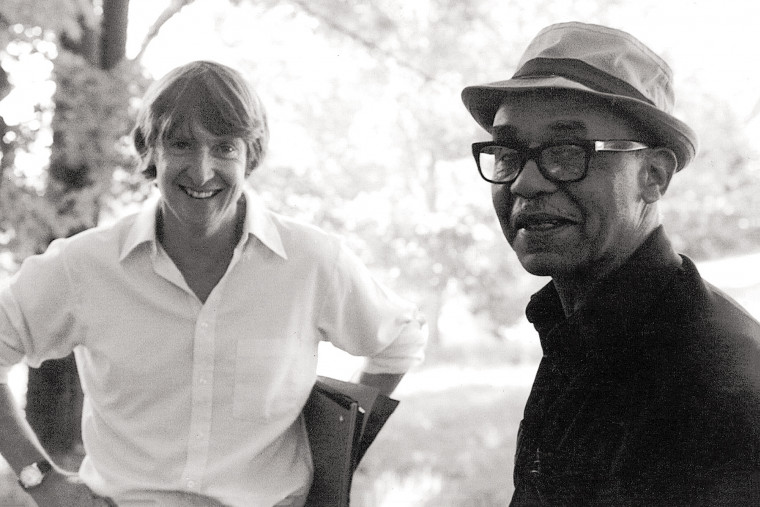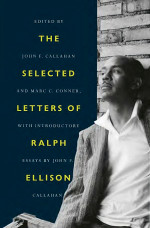Ralph Lives!
Open gallery

John F. Callahan’s latest feat as Ralph Ellison’s literary executor is to reveal him as a man of letters—hundreds of them.
by Angie Jabine
When John Callahan first met Ralph Ellison in 1978, he addressed him as “Mr. Ellison.” In return, the buttoned-up author of the towering Invisible Man addressed the lanky young professor as “Mr. Callahan.”
But within hours, they were on a whiskey-sipping first-name basis, and what began stiffly blossomed into a lifelong friendship based on mutual respect—so much so that after Ellison died in 1994, his wife, Fanny, appointed Callahan as Ellison’s literary executor.
In that capacity, Callahan has overseen the posthumous publication or reissue of much of Ellison’s vast archive, including essays, speeches, and short fiction. In 1999, he boldly distilled the core narrative of Ellison’s sprawling, notoriously unfinished second novel into a 368-page book, Juneteenth, with a preface by author Charles Johnson and an introduction and explanatory afterword by Callahan. In 2010, Callahan and Adam Bradley BA ’96 produced Three Days Before the Shooting …, a massive scholarly edition of the entire unfinished manuscript.
Now comes the equally weighty Selected Letters of Ralph Ellison. Coedited by Callahan and Marc C. Conner, and published in December by Random House, this 1,060-page collection of letters spanning six decades has been welcomed as the unlocking of a literary treasure chest, with admiring reviews in the New York Times, the Wall Street Journal, Bookforum, and more. As the New Yorker put it, Ellison’s voluminous correspondence “constitutes another magnum opus.”
In the public mind, Ellison had been a one-book author, stymied by the instant and enduring success of Invisible Man, from its appearance in 1952 until his death in 1993. Ellison did pursue other interests— sound engineering, photography, hunting, and, of course, teaching and lecturing—but clearly he was never NOT writing. He sent long, heartfelt missives to old friends and relatives, wife Fanny, literary peers, and academics. He often composed multiple drafts of a single letter, and he kept carbon copies of the oneshe sent. Today the vast bulk of Ellison’s correspondence is archived at the Library of Congress.
“I couldn’t help but be astonished by the letters,” Callahan says. “The depth and breadth of them and the diversity of people he wrote to.”
Excerpts From Ralph Ellison’s Letters
November 3, 1941
To Native Son author Richard Wright, who became a friend in the late 1930s:

October 4, 1944
To Fanny McConnell, to whom he was married from 1946 until his death in 1994:
Fanny, I’m stopping this right here. Not because I have no more to say, but because it’s a hell of a first letter. Especially since I had such things, such heartfelt things, to tell you […] So goodnight—not “my love” but you whom I love. Wire me if you’re all right and my fears only fears …
December 3, 1985
To childhood friend Mamie Rhone, on not hearing back from old friends:
… I still feel that an exchange of news fires memory, keeps important details of the past alive, and helps us gauge the meaning of experience as viewed by those who “knew us when.” On the other hand, it might just be that my letters are just too damned long!
These aren’t actually the first Ellison letters Callahan has edited. In 2001 he partnered with Ellison’s friend Albert Murray on an edition of Murray and Ellison’s freewheeling correspondence from the 1950s. Both Ellison and Murray had been musicians before becoming writers, and the book’s title, Trading Twelves, pays tribute to jazz soloists and their top-this 12-bar improvisations.
Later, as Callahan delved into the rest of Ellison’s letters, he realized they told a story “not only of Ralph Ellison but of America from 1933 to 1993, with all the mix of race, technology, everything—it’s all there.”
Callahan’s work on The Selected Letters began in 2013 when he and Marc Conner photographed the letters at the Library of Congress, and accelerated after Callahan retired in 2015 as Lewis & Clark’s Morgan S. Odell Professor of Humanities. Lewis & Clark staffer Angie McGinnis painstakingly transcribed the letters and, with long-distance help from Conner, Callahan organized them for publication.
The letters are presented chronologically. Callahan’s accompanying essays set the stage for each decade, often lightly speculating about mysteries Ellison never quite explains. One such mystery surrounded a brief, pre-Fanny encounter with the writer Sanora Babb, which, Ellison writes, was “no mere holiday but the start of a new phase of my life.” Some of Ralph’s letters to Sanora were clearly missing from the Library of Congress collection. Callahan radiates glee as he describes his subsequent search for the letters—which a fellow Ellison scholar, Tracy Floreani, ultimately uncovered at the University of Texas—and his satisfaction at adding them to the world’s understanding of Ellison. Buoyed by the Letters’ reception, Callahan is once more enjoying the freedom to focus on his own fiction. His Ellison labors have brought him headaches, but too few to dwell on.
Callahan recalls that as a youth in New Haven he’d take the train into New York to visit jazz clubs. In his wanderings, he’d see the same graffiti over and over, “Bird Lives,” a tribute to bebop genius Charlie “Yardbird” Parker, who died at 34 of hard living.
By contrast, Ellison lived until age 81 (and was, incidentally, no great fan of bebop). Still, says Callahan, when he reflects on his own role in tending Ellison’s literary flame, he often thinks to himself, “Ralph Lives. Ralph Lives.”
Angie Jabine is a Portland-based writer and editor.
More L&C Magazine Stories
Lewis & Clark Magazine is located in McAfee on the Undergraduate Campus.
MSC: 19
email magazine@lclark.edu
voice 503-768-7970
fax 503-768-7969
The L&C Magazine staff welcomes letters and emails from readers about topics covered in the magazine. Correspondence must include your name and location and may be edited.
Lewis & Clark Magazine
Lewis & Clark
615 S. Palatine Hill Road MSC 19
Portland OR 97219

